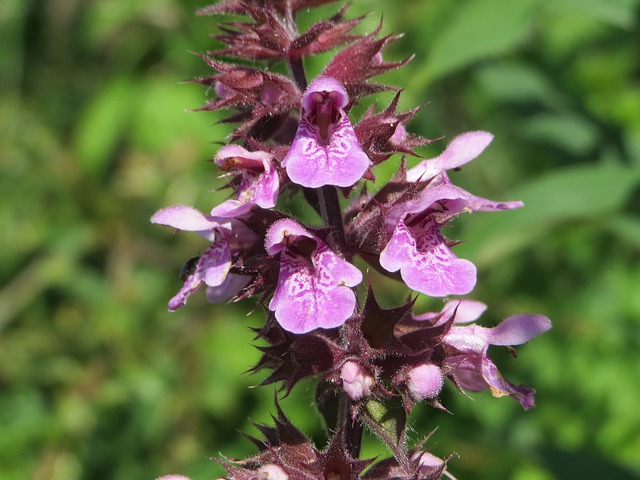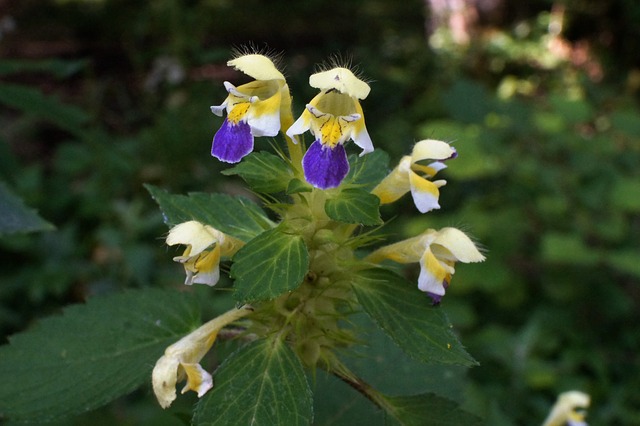Large-flowered Hemp-nettle (Galeopsis speciosa Mill.)
 |  |  |  |  |
 |  |
Representatives of the genus
Hemp-nettle
are herbaceous annual plants from 15 to 100 cm high, common weeds. The stem of the
Hemp-nettle
is branched, erect, tetrahedral, thickened under the nodes, covered with glandular, coarse, protruding setae, prickly to the touch. The leaves of the plant are ovate-lanceolate or rhombic in shape, coarsely serrated along the edge, opposite.
Hemp-nettle
flowers are bisexual, have a two-lipped corolla, a tubular-bell-shaped calyx. Depending on the species, there is a lilac, purple hue. The upper lip of the corolla is yellow, the lower lip has a bright purple spot. The flowers of the plant are collected in inflorescences of 6-10 pieces in false whorls and develop in the axils of the upper leaf plates. The
Hemp-nettle
begins its flowering in the height of summer and blooms almost until the first frost. The fruit of the
Hemp-nettle
is a dry nut that splits into 4 flat nuts. The flowers and fruits of the
Hemp-nettle
are poisonous. The seeds of the plant remain viable in the ground for up to 15 years. One plant can produce up to 8000 nut seeds. An annual plant propagates by seeds.
Despite the fact that there are several species of the genus
Hemp-nettle
, they all have similar medicinal properties and are almost equally used in traditional medicine. For medicinal purposes, the aerial part of the pickle is harvested: flowers, stems and leaves of the plant. The stem is cut off near the ground during the flowering of the plant, before the formation of seeds. Dry in bunches inflorescences down in a well-ventilated area or in the shade, avoiding direct sunlight. Store dried raw materials in paper bags in a dry place for no more than 2 years.
The aerial part of the plant contains a significant amount of silicic acid (about 10%), tannins (up to 10%), iridoids (haliridoside, harpagide, 6-deoxyharpagide, gluroside, 8-acetylharpagide), resinous, bitter and waxy compounds, flavonoids (0, 9% scutellarin), sterols, saponins, tannins, fatty (up to 45%) and essential oils, salicylic, caffeic acids and other substances.
MEDICINAL IMPORTANCE
According to studies conducted by Khvashchevskaya A.A., Fedko I.V. and other employees of the Siberian State Medical University, plants of the Lamiaceae family, in particular piculnik, can be recommended as a source of silicon in the treatment of pulmonary tuberculosis. It has been established that silicic acid is necessary for the strength, elasticity and normal functioning of the connective and epithelial tissues of the lungs, as well as the endocrine glands. Silicon in the body is able to increase self-protective functions. Active silicon compounds help to facilitate the removal of toxins, metabolites, and foreign substances from the body along with urine. The main function of silicon is to support an active metabolism in the body. Due to the presence of salts of salicylic acid and saponins in the composition of the pickle, the aerial part of the plant is used as an expectorant.
The beneficial properties of
Hemp-nettle
have been known in folk medicine for a long time. Infusion of herb
Hemp-nettle
in domestic folk medicine treats respiratory diseases, bronchial catarrhs, asthma, and in combination with horsetail - tuberculosis, since
Hemp-nettle
dilutes sputum and also facilitates expectoration. Alcoholic tincture of common
Hemp-nettle
has a good therapeutic effect in inflammatory processes of the urinary tract, diseases of the excretory system. Due to its anti-inflammatory and antispasmodic medicinal properties,
Hemp-nettle
is used in the form of water decoctions and infusions for various diseases of the digestive system: stomach ulcers, colitis, chronic pancreatitis, and liver diseases.
Hemp-nettle
herb is used as a general tonic for anemia, after severe infectious diseases, to strengthen the immune system. The aerial part of the plant is used in medical collections as a blood purifier. In Bulgaria, the herb
Hemp-nettle
is used to treat leukemia (malignant leukemia), water decoctions of the plant are used to treat cancer, whooping cough. Externally,
Hemp-nettle
grass is used for various skin diseases (neurodermatitis, furunculosis, psoriasis, eczema, felon) in the form of phytoapplications and therapeutic baths.

Common Hemp-nettle (Galeopsis tetrahit L.)
